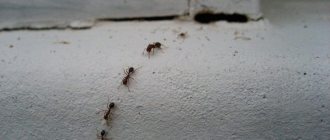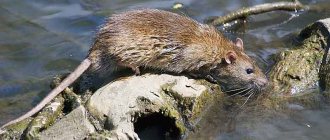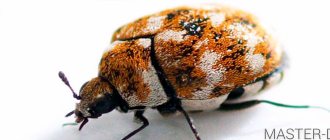The problem of many gardeners is wireworm. The pest itself is the larva of a click beetle, which looks like a caterpillar - a worm. The pest received this name due to its elongated, rigid body, which resembles a short (10-45 mm) piece of yellow-brown shiny wire. The larva lives in the soil, seriously damaging and destroying crops. His favorite plants are potatoes, beets, carrots, onions, cereals, and sunflowers. Moreover, it does not feed on leaves, but exclusively on roots and tubers.
Bait seeding
If the area is heavily affected by wireworm, sow wheat, oats or barley a couple of weeks before planting potatoes. Before planting potatoes, dig up the seedlings. There will be a wireworm there. Collect and destroy it. You can sow grain only in the holes where potatoes will be planted.
This method does not guarantee complete destruction of the wireworm, but it will help to significantly reduce the number of larvae on the site. When planting potatoes, use several additional control recipes.
How to avoid losing crops due to click beetles
So much has been said about Colorado potato beetles! But they are not the most harmful creatures in the garden. They don’t hide from anyone, sit on damaged leaves, and attract summer residents with their bright colors. But going to war with a wireworm is much more difficult. It cannot be poisoned with chemicals or collected from leaves. And it is quite difficult to survive the yellow worm from the site. But it is possible.
Attention! The click beetle itself looks similar to a ground beetle, but the two can be differentiated. To do this, you need to catch the beetle, turn it over on its back and touch its abdomen. The beetle will jump, making the characteristic clicking sound that gives it its name.
On the left is a wire beetle and its larva, on the right is a false wire beetle.
The wireworm is the larva of a fairly harmless click beetle. These insects wake up at the end of April and begin to lay eggs in the ground to a depth of 2-3 cm. Females of various types of beetles lay up to 200 eggs! After about 2-3 weeks, offspring emerge from the eggs. The larvae live on the site for 3-4 years, then pupate and become beetles.
Onion peel
It is best to make a decoction of onion peels and soak the seed potatoes there before planting. You can throw a large armful of onion peels next to a potato bush and dig it in a little so that it doesn’t get blown away by the wind.
The wireworm in potatoes does not tolerate the onion component, so you can, as an option, alternate planting: potatoes and onions.
Planting beans or beans
Plant beans or legumes between the potato bushes. In addition, the Colorado potato beetle does not like these crops. Beans do not protect against the Colorado potato beetle, but they do reduce its numbers on the site.
Plant peas, phacelia, mustard, marigolds or calendula around the perimeter. It is better to alternate sowing green manure and potatoes annually.
Wireworm in potatoes - we fight with potassium permanganate
When planting, water the potatoes with a solution of potassium permanganate. Irrigation with water during planting also increases potato yield. Potassium permanganate is diluted in water until a light pink composition is obtained. Water the hole or from above for planting, as is convenient for you.
When planting in a hole, add a little dry mustard. You can add red hot pepper.
Eggshell. Add ground eggshells to the beds or holes.
Rating of the most effective drugs
If there are a lot of wireworms and you need to eliminate them quickly, the easiest way is to use agrochemicals. Various anti-wireworm preparations for potatoes are popular among gardeners; they have different compositions and principles of action, but many of them are equally effective.
Despite the fact that the means used may be different, the processing process looks approximately the same: put a film on the floor or a flat surface, and lay the tubers on it in one layer. Prepare a pickling solution, pour it into a spray bottle, spray the tubers so that the liquid wets their entire surface. When they are dry, turn them over to the other side. Repeat processing.
The second option: make a solution, pour it into a large container, place the tubers in a mesh and lower it into the liquid. Leave for the time indicated in the instructions. Then dry it by spreading it in one layer in a dry room. Treatment with products should be carried out on the day of planting.
Taboo
Systemic insecticide-protectant for tubers and plant seeds. Protects crops during the period when they are most vulnerable - in the seedling stage. It has a long validity period – up to 1.5 months. The drug is available in the form of a water-suspension concentrate; according to the manufacturer, it is effective regardless of environmental conditions, that is, in any weather. How to use: spray the tubers ready for planting or, alternatively, the soil in the furrows when planting. One treatment is enough, but it should be carried out no later than 3 months before digging up the tubers - that is how long the waiting period for the drug lasts.
Prestigator
This is a suspension concentrate intended for treating tubers before planting. It can be combined with antifungal agents and growth stimulants. When planting the treated tubers, you can fertilize them with fertilizers; the drug does not compete with them.
Prestigitator protects potatoes throughout the growing season; the time for complete decomposition of the active ingredients is 2 months. In this regard, it cannot be used on early varieties.
Zemlin
The drug fights not only wireworms, but also mole crickets. Time of use – dressing of planting tubers in spring and autumn preventive tillage. The insecticide is mixed with sand and this anti-wireworm agent is applied when planting in holes or granules are scattered over the area. The validity period of Zemlin against wireworm is 2 months, so for most varieties one treatment is usually sufficient.
Prestige
One of the most famous insecticides. They are used to treat the tubers before planting. It protects not only from wireworms, but also from another dangerous enemy of nightshades - the Colorado potato beetle. It has a fungicidal effect and protects against fungal infections. It increases germination, strengthens the immune system, and plants treated with it can more easily withstand changing weather conditions. Combines with growth stimulants and complex fertilizers. Protects potato bushes from wireworms throughout the entire period of their growth. Restriction on the use of Prestige: not suitable for early varieties.
Zarit
In addition to wireworms, it destroys mole crickets. The granules are laid out on the site or buried in the ground to a depth of 5-10 cm.
Initiative
Microgranules of poison are embedded in the soil, evenly distributing them in it, which ensures the necessary contact with pests. Destroys them within 24 hours, valid for 1.5 months. Pochin is not phytotoxic; it cannot be mixed with other agrochemicals.
Chops
The drug is a ready-made bait for poisoning pests. These are granules that are evenly embedded in a layer of earth at a depth of 5-10 cm. Rubit should not be mixed with fertilizers or any medications. The insecticide is non-toxic for plants.
Barguzin
Barguzin is available in the form of emulsion concentrate and granules. According to the instructions for use, its effect is noticeable within 3-4 days after treatment - application to the soil when planting or detecting wireworms. Protects plants for more than 3 weeks, which is quite enough at the initial stages of their growth. It is non-toxic for all types of plants and is compatible with many agrochemicals of different classes.
Provotox
To kill the pests, a single application of Provotox against wireworms in the holes during planting is sufficient. You can distribute it over the entire area of the beds, embedding the granules to a shallow depth. It is not recommended to use the insecticide on early varieties of potatoes and mix it with other agricultural products.
Wireworm in potatoes and weeds
Many professional gardeners have noticed that the wireworm loves wheatgrass. Destroy this weed in your garden. Also, after harvesting potatoes, you need to clear the area of all weeds. Wheatgrass contains all the useful substances for feeding the beetle larva, so where there is an accumulation of this weed, always look for a lot of wireworm.
In addition, the pest multiplies in wheatgrass. the weed itself can reduce potato yields by 70%. The creeping plant wraps around the root of cultivated plants and clogs their growth.
Why does the wireworm start?
You need to know the reasons for the appearance of a parasitic worm. In order to start fighting it, you need to know in which direction you need to act. Ideal conditions for wireworms are:
- Acidic soil with the presence of weeds, especially wheat grass and thistle;
- Constantly moist soil;
- Poorly fertilized heavy and clay soil;
- Vegetables planted close to each other favor the development and reproduction of larvae.
Pay attention to whether yours is among these reasons. By eliminating them, perhaps in 2-3 years you will remove the wireworm.
Wireworm in potatoes - we fight with folk remedies
Infusion for watering. The broth is infused for 3 days and the potatoes are watered every other day for a week (4 waterings), then take a break for 7-10 days. After this, you can repeat watering.
- Water – 10 l.
- Nettle – 0.5 kg.
- Mother and stepmother (flowers) – 0.2 kg.
- Celandine (needs to be crushed) – 0.1 kg.
- Dandelion – 0.2 kg.
Folk remedies remain the most effective for both potato growth and the quality of the future harvest. Do not neglect it and may your crop never know what wireworm is in potatoes.
You might be interested:
Tips for summer residents
Weed control (different methods)
How to get rid of slugs
Brief conclusions
Wireworms are considered one of the most dangerous pests: they attack both vegetable crops and other useful plants, even the roots of young fruit trees. Since the life expectancy of these larvae is long, and new pests can be brought into the area by adult click beetles, it is impossible to completely and permanently control the wireworm. To reduce the harm caused, all possible measures are used: you should not immediately rush to extremes and buy insecticides, you can try sowing green manure and setting up traps on the site.
Other methods of controlling wireworms
In the case of wireworms, the “all means good in war” method works 100%. Therefore, we learned a couple more effective tricks needed in the difficult struggle for the vegetable garden.
- Attract birds to the site - crows, wagtails, rooks, starlings, thrushes and tits - they willingly eat click beetles and their larvae. Leave feeders and treats for the birds;
— Reduce soil acidity using eggshells, bone meal or ash;
— Plant plants between the beds that repel wireworms. These are mustard, spinach, lupine, buckwheat, rapeseed, sweet clover, dahlias and any legumes;
— If nutcrackers have settled in the garden bed, next year plant resistant crops there: pumpkin, greens, cereals or beans;
— Seasonal digging of the soil should be carried out especially carefully and deeply, because in the warm season the larvae get closer to the surface. And be sure to carry out deep digging before frost to destroy the wireworm, which has already laid down for the winter;
— Before planting potatoes, sow the bed with cereal or corn seeds. During this time, the wireworm will come out for new food - and you will destroy the larvae along with the first planting.
Photo: mastergrad.com
Castor bean (50 photos): types, care and planting in open ground
Agricultural technology guarding the garden
In the fall, it’s time to sow green manure, which will enrich the soil with nitrogen and phosphorus and repel the pest.
Table: green manure against wireworms
| Green manure | Peculiarity | When to sow | Usage |
| White mustard, rapeseed | Essential oils disinfect the soil | September-early October | Dig in shoots 10 cm high |
| Annual lupine | Deoxidizes the earth; nodule bacteria suppress wireworm activity | In early September | After 45–50 days, mow and dig up |
| Phacelia | Neutralizes, loosens, disinfects soil | All September | Seal for digging after 40 days |
| Rye | Loosens the soil | Before winter | Digging up spring shoots |
Autumn planting of green manure for a long time discourages wireworms from “walking” in this area
Mechanical techniques
At the end of the season, the area is carefully cleared of plant debris both on the soil surface and in the ground. This is especially true for potatoes the size of peas; wireworms flock to them like moths to a light. Waste is burned off-site if it is to be used for traps.
The land is cleared of weeds - milkweed, burdock, sow thistle, woodlice, wheatgrass. They do not tear the plants, but dig them up, selecting the roots where the wireworm lives.
Wheatgrass roots look like a jungle where wireworms happily live
Until the larvae lie “at the bottom” to spend the winter, on the eve of frost the area is dug up with a shovel, turning over clods of earth. If there are pests, then 70–90% of them are guaranteed to be gone. During routine work in the garden: hilling, planting and replanting, the wireworm is picked out by hand; fortunately, its color catches the eye.
The bright, glossy chitinous shell of the wireworm is visible to the naked eye even against a variegated background.
Why is it dangerous for potatoes?
Feeding on root crops, the wireworm makes deep tunnels in them, which leads to loss of presentation of the product, spoilage and rotting in the future.
When damaged by wireworms, the presentation of the potato is immediately lost.
Damaged tubers become watery, quickly become flabby and darken . The waste products of the larvae left in the potatoes also contribute to rapid fermentation.
When harvesting potatoes, you need to carefully discard damaged material. If the larvae get into the vegetable storehouse, they can damage almost the entire crop, moving from one tuber to another.
Mechanical wireworm traps
Banal mechanical traps work well against voracious larvae. We offer several proven options:
— Bury jars of chopped potatoes and carrots near the wireworm-infected bed. Cover the neck with foil and cut small holes so that beetles and larvae can get in, but cannot get out;
— String the remains of the old crop on a wire and dig it into the ground, leaving the end outside. After three days, pull the vegetables by the wire and destroy them along with the larvae;
— Adult beetles can be lured by a pile of manure or freshly cut grass;
— Generously pour sawdust soaked with insect poison into a glass jar. Dig the jars into the ground up to the neck in different places between the beds;
- Soak old and spoiled potato tubers in insecticide for a day and scatter them over the garden bed, adding a little bit. After a few days, replace the trap with a new one until the wireworms disappear from the garden.
Photo: beztarakanov.ru
Description of the potato pest
The size of the wireworm ranges from 1 to 5 cm. As mentioned above, it has a hard body, like wire. Color can vary from yellow to dark brown. It will be difficult to crush him.
Photo of wireworm
The development of the click beetle takes place over 5 years, while it remains in the larval stage for 3 or even 4 years. In the first year of life, the larva is not as dangerous as when it matures. In the 4th year pupation occurs.
Wireworms eat almost everything. They are considered polyphagous.
They consume roots, stems, and shoots. They eat seeds and seedlings. Passages are made in the fruits, and therefore they are poorly stored and become completely unsuitable for food.
Photos of the main stages of development of the click beetle
Preventative treatment
To get rid of wireworms forever, you need not only to destroy them, but also to carry out preventive measures every year that will no longer allow them to appear on your site. Such events include:
- How to treat strawberries during fruiting
- change the place for growing crops at least once every 2-3 years;
- Carrying out annual spring and especially autumn digging of the site to the depth of a spade bayonet. The larvae raised from the depths of the soil during autumn digging will die from the cold in winter, and spring tillage will clear the soil of the roots of weeds on which wireworms feed;
- loosening the soil in the area in May-June, so that the eggs of the click beetle fall to the surface, where they die from the sun's rays;
- regular weeding of the area, carried out to cleanse the soil of wheatgrass and other weeds. If the weed situation is critical, use Roundup to kill it;
- keep the area clean, remove grass and tops in the fall, in which the wireworm likes to spend the winter comfortably;
- To repel click beetles, you can grow marigolds, the aroma of which attracts pests, despite the fact that the juice of these plants is poison for them. Wireworms in the garden are afraid of legumes (black beans, soybeans, peas and beans), because bacteria that produce nitrogen live in their roots. To enhance the effect, you can sow phacelia together with legumes, which neutralizes acidic soil;
- The wireworm on the site does not like plants such as mustard, rapeseed, buckwheat, spinach, sweet clover, rapeseed and oilseed radish, so once every 2-3 years, in line with potatoes or root crops that the wireworm feeds on, you need to sow one of the listed crops In this case, the larvae will either die or, turning into beetles, will leave the area;
- those who have used rye against wireworms claim that it not only does not repel pests, but, on the contrary, attracts them. In addition, this crop takes too much moisture from the soil, so it is better to grow other plants as green manure;
- A very effective way to combat wireworms is to treat the surface of the area with table salt once every seven years (not more often).
Well, some advice for those who have just started cultivating a plot of land: there are a lot of wireworms in the virgin soil, so in the first years, until you remove all the larvae and all the roots of the weeds from the ground, it is better not to grow potatoes and root vegetables on the plot. Plant legumes, nightshade or pumpkin crops for now.
How to identify a wireworm
I wrote that the garden pest prefers to live in the ground, feeding on root crops, which makes it difficult to meet it “face to face.” You can tell if there are wireworms in your area by the following characteristic signs:
- In tubers and root vegetables there are black dots, spots, narrow winding passages.
- Only individual bushes are damaged, and not the whole ridge or plantation. Wireworms can dig a vertical passage up to 1-2 m. But it is difficult to move in the horizontal direction - a maximum of 20-30 cm. Therefore, they prefer to feed on 1-2 neighboring plants.
- During the period of pest activity, it is possible to detect when digging up a garden in the upper layers of the soil.
Another sign is the appearance of adult click beetles. Outwardly, they are almost indistinguishable from useful ground beetles. However, the pest, turning over from its back to its abdomen, makes a clicking sound.











